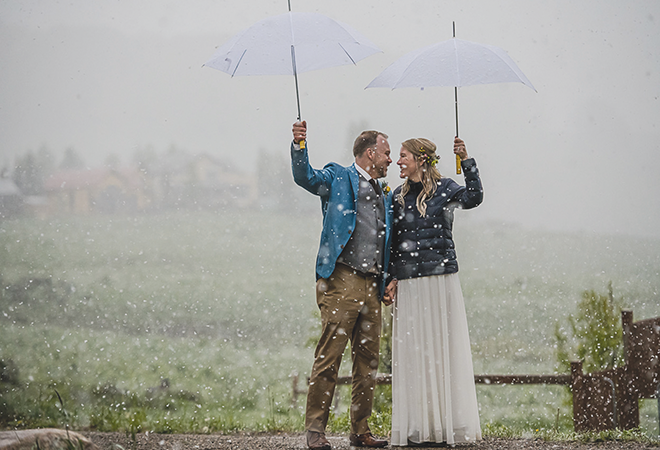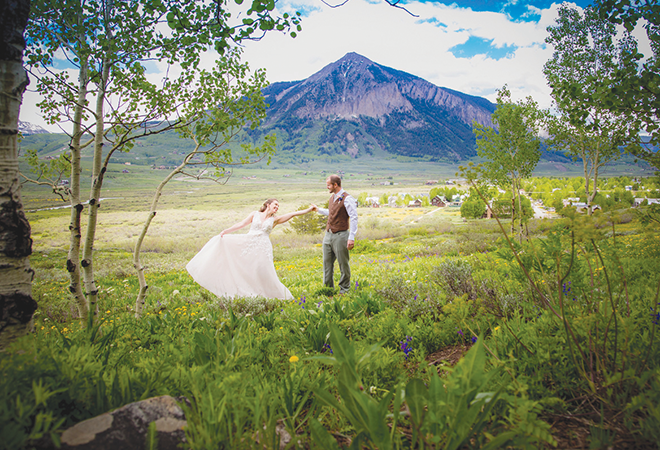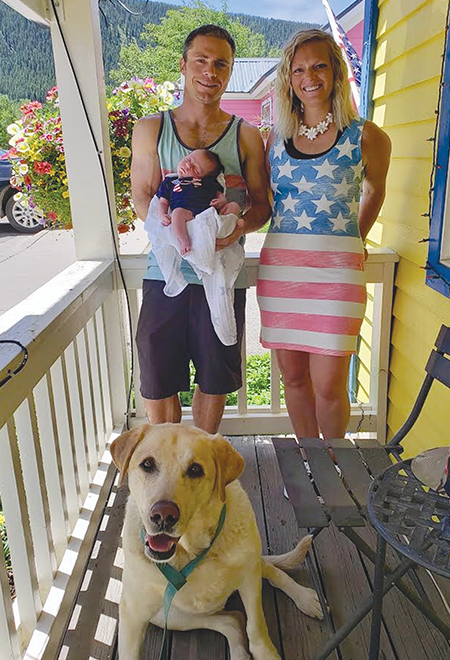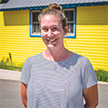From teepee to techie
By Dawne Belloise
Dan Jones sits framed by a small forest in his front yard. He seems to be as tall as the aspens that surround him. He tells the story of how his grove of quakies grew from seedlings planted by the now-exiled Amax mining company. “These were put in a cavern under Mt. Emmons as part of Amax’s reforestation project, that grew into little trees and when they pulled out, Amax put all the seedlings on two flatbed trailers and took them down to the Four-way Stop. Jeff Siefried and I took all the plants we could, sold them, gave them to friends and everything that looked like it was too weak to make it, we put in our yard. And as a result, I have 54 trees.”
Dan arrived from Aspen in the dusty little ski resort of Crested Butte in 1974. When he and his partner/companion, Jeff, bought the house on Second Street in 1976, Dan recalls that the yard was nothing but sagebrush and a 1954 Mercury up on blocks. It was the far northwest end of town with no houses beyond their property, just pasture and views.
Born and raised in Seattle, Dan says, “It was fabulous. I grew up on Sunset Hill above the water. I was lucky enough to be in a big house with a big family, three sisters and a house full of German shepherd dogs. It was a three-story house and there was usually a pack of dogs everywhere.” All his grandparents hail from Sweden and when he was young, his parents took the family to the motherland. Dan says, “We drove all over searching for family records in churches,” and he got to meet his family there.
At 6’4”, Dan played basketball in high school. He graduated in 1966 and emphasizes, “I got so angry at my country for the Vietnam War that I left the country after graduation and lived in Switzerland for a year,” working as trail crew at a ski resort in a small town like Crested Butte. “I was skiing around all day with a shovel. There were German shepherd avalanche dogs all over. I was in love,” he smiles.
When he returned to the United States, Dan attended the University of Washington, graduating in 1970 with a BA in English literature. While in college, he was on the rowing team but after graduation he realized, “All I wanted to do was ski my butt off. My parents had started me skiing when I was a child and that’s all I wanted to do.” He eventually became a ski patrol.
Dan was in San Francisco in 1971. “I love San Francisco, it’s the ancestral motherland of homosexuals,” he laughs. He was a gypsy taxi driver even though he couldn’t pass the test, which was mostly a geography test and he didn’t have a clue as to where anything was in the city, “but they handed me the license anyway.” The calls for fares would go to a phone booth behind a Sinclair gas station but the only way to make money, Dan says, was to hang out at a hotel and wait to take customers to the airport.
Following the snow, Dan was a houseman at Sun Valley tasked with driving the maids around all day, carrying their vacuum cleaners upstairs for them and bringing firewood into the condos. As he recalls, “And then, we’d break into other condos and drink all their liquor.” Dan had moved to Aspen in 1973 because the skiing was so good. He landed a job at the prestigious Refectory restaurant, a chain of high-end eateries. It was in Aspen that he met Jeff Siefried, and having hit it off over an offered slice of pizza, the two skied up to Crystal the next day, where Jeff was living in a teepee in the middle of the river on an island. The couple then took off to travel Colombia, South America.
They returned to Aspen for a short while, then moved to Vail to work on Avon’s sewer system until they heard about this crazy little ski town called Crested Butte. Dan and Jeff were hired to help build the Irwin Lodge and Dan remembers, “We lived in a teepee down at Ruby Anthracite with Linda Baker. We’d hike the mile and a half up the river to work. We were young and tough. We’d go work and then hike back down to the teepee. It was a great lifestyle. We’d build little pools to jump into. We had pet trout. We made sweat lodges by bending willow branches and then we’d put blankets over the branches. I still feel Irwin is my neighborhood.”
Later, in 1974, he and Jeff opened the very popular restaurant, The Vineyard, serving fondues of meats, bread and chocolate. They sold the eatery a decade later and went their separate ways.
After the restaurant sold, Dan left for Pennsylvania, working as finance director for a Democratic congressman, who later moved him to the Washington, D.C. office. He had worked in Dallas on the Carter/Mondale campaign, having learned computer software when his college rowing coach got him a job at a Seattle bank as a programmer.
Dan was not thrilled when his boss sent him to Texas. “I didn’t want to go to Houston but somebody had to go and I was the one who was the most techie.” He was in the Lone Star State from 1985 through 1991, until, “My partners were tired of me whining about wanting to go back to Crested Butte,” so they sent him home to work remotely.
Back in Crested Butte, when the CF&I mining company decided to sell their land on Gibson Ridge and the town of Crested Butte couldn’t come up with the $2.1 million to purchase, Dan and a group of friends realized the gravity of not having control of potential development land surrounding town. The property was bought by a developer who then built exclusive homes on what was once the coal mines overlooking town. Dan, Jim Starr, John Hess and Norm Bardeen took the initiative in creating the Crested Butte Land Trust in 1992 in order to have a plan and funding in place for the next time strategic property came up, “To preserve the present for the future. We begged, borrowed and everything up to stealing,” Dan says of their fundraising efforts. Then they convinced the town to enact the real estate transfer tax, which takes 3 percent of all real estate sales in town, “and that’s when the Land Trust was able to really start. It gave the trust a source of funding that without it, we’d never be able to conserve land,” Dan says.
Dan was an avid rower, spending his days out on Lake Irwin, Long Lake and Blue Mesa and he laughs, “I’m pretty sure I was the highest rower in the world, in every sense of the word,” but continuing issues with his legs and knees forced him to quit. “It was clear that my rowing career was closing so I decided to drive my old blue Bronco as far as it would go from Seattle. I was hoping for Patagonia,” and he took off to San Francisco. “I thought if I made it into South America and the car died, I could leave it in some village and they would love it because they would take care of it and fix it and they’d all be happy and I’d go home and start doing something else. But I didn’t make it that far.”
His ex Jeff asked Dan to stay in his San Francisco apartment for a few weeks while he flew off to Hawaii. A few weeks turned into a few months, and he took computer programming temp jobs. He discovered Vivid Studios, the cutting-edge tech firm and web developer at the time, and went in to apply for a job, donning his business suit. “There were Frisbees flying, wildly dyed hair, dogs running around and computers everywhere. Everything that you think about when you think of San Francisco, Vivid Studios was emblematic of all of that and more.” He just turned around and left, completely intimidated. Returning another day, in casual dress, he made them an offer to work for free for a month and if they liked him, they could pay him. He went on to become the vice president of the company, from 1995 to 2001, when he retired.
Back home in Crested Butte since, Dan feels, “I love the mountains, what’s not to love? I love this town and always have. This is my home, this community first and foremost. I just want to be here.”
 The Crested Butte News Serving the Gunnison Valley since 1999
The Crested Butte News Serving the Gunnison Valley since 1999








